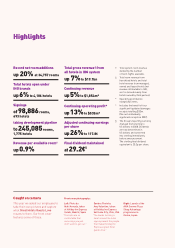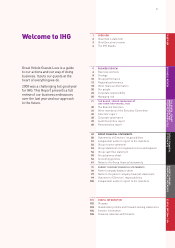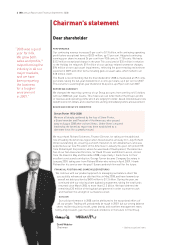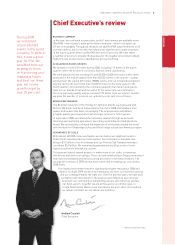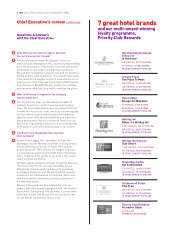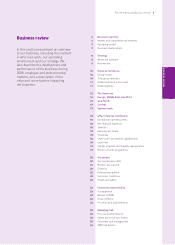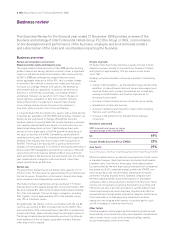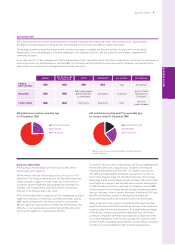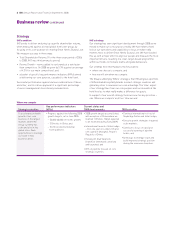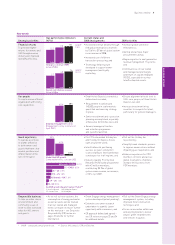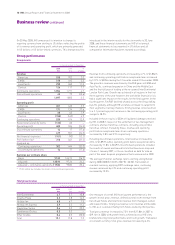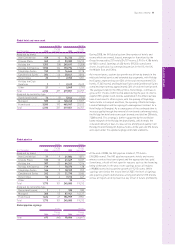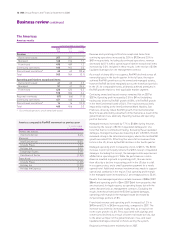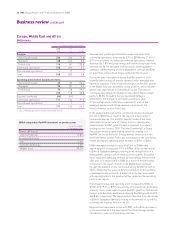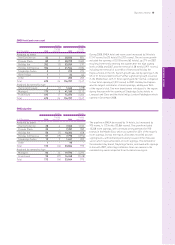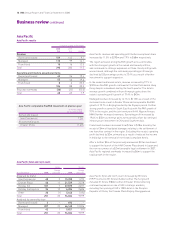Holiday Inn 2008 Annual Report Download - page 8
Download and view the complete annual report
Please find page 8 of the 2008 Holiday Inn annual report below. You can navigate through the pages in the report by either clicking on the pages listed below, or by using the keyword search tool below to find specific information within the annual report.
6IHGAnnual Report and Financial Statements 2008
This Business Review for the financial year ended 31 December 2008 provides a review of the
business and strategy of InterContinental Hotels Group PLC (the Group or IHG), commentaries
on the development and performance of the business, employee and environmental matters
and a description of the risks and uncertainties impacting the business.
Business overview
Market and competitive environment
Global economic events and industry cycle
The unprecedented financial events of late 2008 and the resulting
global recession are having, and will continue to have, a significant
impact on IHG and the wider hotel industry. IHG’s share price fell
by 36% in 2008 and, although we outperformed our peers,
whose aggregate share price fell by 49%, this is a major change
in sentiment. We continue to monitor key trends and indicators
to ensure our strategy remains well suited to the developing
environment and our capabilities. In essence, we believe our
business is resilient and, accordingly, our strategy remains
unchanged. However, we see short-term risks in the pace of
future openings, availability of debt and consumer demand.
None of these factors is expected to require major change
to our strategy and we remain focused on the medium to
long term, while we protect short-term profitability.
It is beyond doubt that this downturn is severe, with a sharp decline
in revenue per available room (RevPAR) and bookings. However, we
believe we are well placed to manage through this economic
situation, despite its severity. While the current downturn is unusual
in its rapidity, unpredictability and degree of credit restriction, our
industry has always been cyclical. Traditionally we have seen
periods of five to eight years of RevPAR growth followed by up to
two years of declines in RevPAR. Demand has rarely fallen for
sustained periods and it is the interplay between hotel supply and
demand in the industry that drives longer-term fluctuations in
RevPAR. The Group’s fee-based profit is partly protected from
changes in hotel supply due to its model of third-party ownership of
hotels under IHG management and franchise contracts. IHG profit
varies more with hotel revenue (demand) than it does with hotel
profit performance. We believe we are well placed over the coming
year compared with competitors who own hotels, rather than
simply operate them, as IHG does.
Market size
The global hotel market has an estimated room capacity of 17.5
million rooms. This has grown at approximately 2% per annum over
the last five years. Competitors in the market include other large
hotel companies and independently owned hotels.
The market remains fragmented, with an estimated 7.7 million
branded hotel rooms (approximately 45% of the total market). IHG
has an estimated 8% share of the branded market (approximately
3% of the total market). The top six major companies, including
IHG, together control approximately 42% of the branded rooms,
only 19% of total hotel rooms.
Geographically, the market is more concentrated with the top 20
countries accounting for 80% of global hotel rooms. Within this,
the United States (US) is dominant (more than 25% of global hotel
rooms) with China, Japan and Italy being the next largest markets.
The Group’s brands have more leadership positions (top three by
room numbers) in the six largest geographic markets than any
other major hotel company.
Drivers of growth
US market data historically indicates a steady increase in hotel
industry revenues, broadly in line with Gross Domestic Product,
with growth of approximately 1.5% per annum in real terms
since 1967.
Globally, we believe demand is driven by a number of underlying
trends:
• change in demographics – as the population ages and becomes
wealthier, increased leisure time and income encourages more
travel and hotel visits: younger generations are increasingly
seeking work/life balance, with positive implications for
increased leisure travel;
• increase in travel volumes as low-cost airlines grow rapidly;
• globalisation of trade and tourism;
• increase in affluence and freedom to travel within emerging
markets, such as China; and
• increase in the preference for branded hotels amongst
consumers.
Branded v unbranded
2007 branded hotel rooms by region
as a percentage of the total market
US 69%
Europe, Middle East and Africa (EMEA) 33%
Asia Pacific 29%
Source: IHG analysis, Northstar Travel Management, Smith Travel Research (STR).
Within the global market, a relatively low proportion of hotel rooms
is branded; however, there has been an increasing trend towards
branded rooms. Over the last three years, the branded market
(as represented by the nine major global branded hotel companies)
has grown at a 3.6% compound annual growth rate (CAGR), over
twice as quickly as the overall market, implying an increased
preference towards branded hotels. Branded companies are
therefore gaining market share at the expense of unbranded
companies. IHG is well positioned to benefit from this trend. Hotel
owners are increasingly recognising the benefits of working with
IHG which can offer a portfolio of brands to suit the different real
estate opportunities an owner may have, together with effective
revenue delivery through global reservation channels. Furthermore,
hotel ownership is increasingly being separated from hotel
operations, encouraging hotel owners to use third parties such
as IHG to manage or franchise their hotels.
Other factors
Potential negative trends impacting hotel industry growth include
the possibility of increased terrorism, environmental considerations
and economic factors such as those now prevailing, namely
recession and global credit restrictions.
Business review


